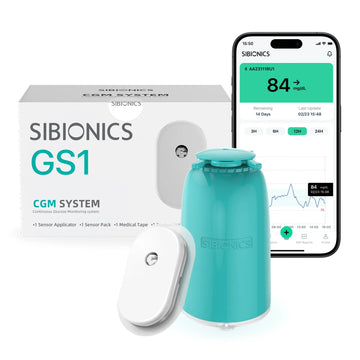Understanding Glycemic Variability During Marathon Training: How CGM and Sibionics GS1 Optimize Performance
Marathon training demands meticulous attention to nutrition, hydration, and energy management. For athletes, maintaining stable blood glucose levels is critical to sustaining endurance, avoiding "hitting the wall," and optimizing recovery. Continuous Glucose Monitoring (CGM) systems like Sibionics GS1 are revolutionizing how runners understand and manage their glycemic patterns. This article explores the role of glucose dynamics in marathon training, the advantages of CGM over traditional methods, and how real - time data empowers athletes to perform at their peak.
1. Glycemic Fluctuations: The Hidden Challenge in Endurance Sports
During prolonged exercise like marathon training, the body relies heavily on glycogen stores and fat metabolism. However, glucose levels can fluctuate unpredictably due to factors such as:
-
Training intensity and duration: High - intensity sessions deplete glycogen faster, increasing hypoglycemia risk.
-
Nutritional timing: Improper carb intake before/during runs may lead to energy crashes.
-
Stress and hormonal responses: Cortisol and adrenaline spikes can temporarily elevate blood glucose.
Traditional fingerstick glucose meters (BGM) provide only snapshots of glucose levels, making it difficult to track trends. This is where **Sibionics GS1**, a cutting - edge CGM system, offers a game - changing advantage. Its 24/7 glucose monitoring captures real - time trends, helping athletes identify patterns like post - meal spikes, nocturnal dips, or exercise - induced hypoglycemia.
2. CGM for Non - Diabetic Athletes: Beyond Diabetes Management
While CGMs are widely used by diabetics, non - diabetic marathoners benefit immensely from glucose insights:
Personalized fueling strategies: Real - time data helps athletes determine optimal carb intake timing and quantity.
Avoiding energy crashes: Alerts for impending hypoglycemia allow timely intervention (e.g., consuming gels or sports drinks).
Enhancing recovery: Post - workout glucose trends inform glycogen replenishment needs.
Sibionics GS1 stands out with its medical - grade accuracy, waterproof design, and 14 - day wear time—ideal for long training cycles. Unlike BGMs, which require frequent finger pricks, the GS1’s discreet sensor provides seamless, painless monitoring, ensuring athletes stay focused on their goals.
3. GS1 vs. Traditional BGM: Why Continuous Data Matters
Traditional BGMs have limitations that hinder performance optimization:
Limited data points: Single readings miss trends like gradual declines during long runs.
Inconvenience: Frequent pricking disrupts training and fails during activities like swimming.
No predictive insights: BGMs cannot warn users about impending highs/lows.
In contrast, Sibionics GS1 offers:
Dynamic glucose profiles: Visualize trends via the app, including post - meal responses and exercise impacts.
Customizable alerts: Set thresholds for hypo/hyperglycemia to prevent energy dips or overfueling.
AGP (Ambulatory Glucose Profile) reports: These summaries highlight daily patterns, helping athletes and coaches refine training and nutrition plans.
For example, a runner might discover that consuming bananas 30 minutes before a run stabilizes glucose better than energy bars, thanks to GS1’s detailed feedback.
4. Stabilizing Glucose for Peak Endurance and Recovery
Maintaining glycemic stability is key to marathon success:
Preventing "bonking": Hypoglycemia mid - run forces the body to slow down, impairing performance.
Optimizing fat adaptation: Stable glucose levels promote efficient fat metabolism, preserving glycogen for high - intensity segments.
Reducing inflammation: Post - run glucose spikes linked to prolonged recovery and muscle soreness.
With **Sibionics GS1**, athletes can experiment with different pre - run meals, hydration strategies, and pacing to identify what keeps their glucose in the ideal range (70–180 mg/dL). Over time, this data - driven approach builds resilience and consistency.
5. The Future of CGM in Sports: A Growing Market
The global CGM market, valued at $7 billion in 2023, is expanding rapidly into fitness and wellness. Europe, with its strong marathon culture and tech - savvy population, is a key growth area. Athletes increasingly demand tools like Sibionics GS1 to gain a competitive edge, while coaches use aggregated CGM data to tailor programs. As research continues to link glucose stability with performance metrics, CGM adoption in sports will likely become mainstream.
Conclusion: Elevate Training with Sibionics GS1
For marathoners, glucose isn’t just a diabetic concern—it’s the fuel that powers every stride. Sibionics GS1 transforms how athletes harness glucose data, replacing guesswork with precision. By uncovering hidden glycemic patterns, runners can fine - tune nutrition, avoid energy crashes, and unlock their full potential. Whether you’re a seasoned marathoner or a beginner, integrating CGM into your training could be the breakthrough your performance needs.



